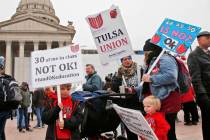BOOK COLUMN: Rediscovering the forgotten man
Here’s a longer version of this week’s column on the late U.S. Sen. Howard Cannon that ran in the Review-Journal.
You probably missed it as you rushed into the morning maelstrom at McCarran International Airport. Or maybe you didn’t notice it as you struggled with your suitcases after running the gantlet at Baggage Claim following a long flight home.
It’s understandable. After all, who goes to McCarran International Airport to experience a museum?
The Howard W. Cannon Aviation Museum stands like an afterthought just inside McCarran’s parking entrance, just a short stumble from the moving walkway and one floor above the beehive of Baggage Claim. It’s a spiffy little museum that celebrates Southern Nevada’s seat-of-the-pants aviation beginnings. From photos of the old Alamo Airport to a uniform worn by a Western Air Express pilot, commercial flight fans will have a field day.
And it’s only fitting that it’s named after Cannon, who in my mind has long been the most important forgotten man in Nevada politics. He represented Nevada in the U.S. Senate from 1958 to 1982, and I’ll bet a majority of the state’s residents don’t recognize his name.
The airport that houses Cannon’s namesake museum is named in honor of Pat McCarran, the iron-fisted patronage king who these days is known more for his connection to McCarthyism than for anything he accomplished on behalf of the Silver State. McCarran’s name is secure.
Despite Cannon’s many contributions to the state, his name seemed destined to fade like a bad dye job.
The Reno Airport was renamed the Reno-Cannon International Airport in 1979 at the height of the senator’s power. It was a distinction that put him in the company of the legendary McCarran himself.
By 1994, the Northern Nevada airport was renamed Reno-Tahoe International. Cannon’s stature was reduced to the “Howard W. Cannon Terminal.”
Terminal, indeed.
Although Cannon lived another eight years, he suffered from Alzheimer’s disease and was seldom seen around the Democratic political machine he’d oiled so well for so long. It seemed Cannon’s name would die with the man.
In his day, Cannon led the Armed Services Committee and the Commerce, Science, and Transportation Committee. He was a Senate titan, an inside player.
When I visited him in his Washington office in the summer of 1982, I was prepared to shake hands with a larger-than-life character. At that time he was among the most powerful Democrats in the country.
What I experienced was a tired little guy with a cheap sport coat and a terrible dye job who had difficulty mustering the energy to complete a simple sentence. Little did I understand then that he was being politically mugged on the record and behind the scenes and was on his way out of Washington and being threatened with possible criminal charges in connection with his old Teamsters associations, who were accused of attempting to bribe him.
The unassuming Cannon would survive his final ignominious months in office, be defeated by one-term wonder Chic Hecht, then blend back into the landscape, a Southwest Utah Mormon boy who was so shy he would never dream of telling you he was a hero in World War II.
Whenever I find myself chasing a flight at McCarran, I can’t help thinking about Howard Cannon, about what a big man he had been and how he’d been lost to Nevada history like a piece of scuffed luggage. There’s a lesson in that for a lot of today’s big shots.
It’s a lesson driven home throughout Michael Vernetti’s new book, “Senator Howard Cannon of Nevada: A Biography.” Vernetti chronicle’s Cannon’s unlikely rise to power from his Mormon roots to his final days. Vernetti’s solid research and interviews were augmented by his time as Cannon’s Senate aide.
Were it looking for a scalp or scandal, the University of Nevada Press might easily have found a tougher Cannon biographer than Vernetti. A man of Cannon’s time and political influences generates no shortage of intriguing associates and benefactors. But Cannon’s Teamsters connections were tilled long ago.
Instead, we have a nicely crafted book that aches with a kind of sadness for Cannon’s seeming inability to celebrate his successes.
“It is probably less critical than it would have been if the author hadn’t known him and worked for him,” says College of Southern Nevada history professor Michael Green says, who helped shepherd the story into print. “But this is an incredibly important Nevada political figure and we have needed a good, solid biography of him for a long time. He’s been out of office for over a quarter of a century. Most Nevadans don’t know him now except as a name on a museum.”
Kenneth Fernandez of UNLV’s Political Science Department observes, “That’s how politics works. When you have political clout, people care about you, and you’re invited to the parties. When you don’t have political clout, people are going to replace you. In reality in politics, relatively few people make a name for themselves.”
At least, not one that lasts.
“Someone wrote a book about him," Fernandez says, “I guess he’s not completely forgotten.”
Vernetti’s book at last gives the forgotten man of Nevada politics some of the recognition he deserves.









